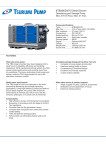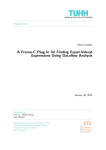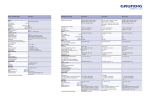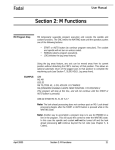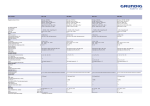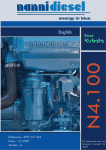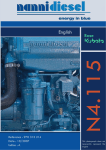Download the user`s manual - Impulse Holding BV
Transcript
USERS MANUAL Impulse reciprocated pumps, series IP. This user’s manual is written by the manufacturer for the proper use of the equipment, and must be completely read before use. Installation, or equipment has to be used as written down in this manual. This manual is only wrote for the purpose of the equipment, installation, and normal daily maintenance. Service, repairs and maintenance which are more than daily inspections are descript in the workshop manual of Impulse series IP. Usage: Impulse, series IP, reciprocated pumps are designed and developed for ground water level controlling, and temporary dewatering purposes. The pumps can be descript as a clean water press pump. This “clean water pump” is only usable in combination with vertical filters, with maximal perforations of 0.7 mm. or can the pump be used in combination with horizontal drain tube (with a filter system around) on the suction side. The design of the pump gives you low running speed (380 rpm on pinion shaft) in combination with high vacuum capacity. The construction is simple, heavy designed, and needs a minimum of maintenance by proper use. The total construction is based on low running cost and is very efficient according power consumption. The Impulse, series IP, can be found mostly in construction projects as tunnelling, pipe lines, building areas, foundations, railway tracks etc. where the building area has to be dry below the surrounding ground water level. After reading and handling according this manual you can use the Impulse series IP without any unexpected issue, and we wish you a dry working area! Impulse Pumps BV UME-012007 TECHNICAL DATA IMPULSE SERIES PUMP TYPE Cylinder diameter Installed engine power Max. Capacity Max. Head Max. Vacuum Bare end pump weight Efficiency, up to IP-175 175 mm 7,5 kW 95 m3/h 22 mtr. 9.4 mtr. 825 kg. 92% IP-160 160 mm 5,5 kW 65 m3/h 22 mtr. 9.4 mtr. 825 kg. 92% IP-145 145 mm 7,5 kW 54 m3/h 65 mtr. 9.4 mtr. 825 kg. 92% Materials: Pump casting Gearbox casting Cylinders Piston rods Collars Piston bodies Valve seats Valves Crankshaft Connecting rods Valve stem guide screws Studs in pump body Gear wheels on crank Pinion shaft Pulley : Cast iron, > GG20 : Cast Iron, > GG20 : Stainless steel, 304 : Stainless steel, 304 : Special rubber : Moulded glass filled nylon : Brass : Moulded rubber with steel plate inside : Cast steel : Cast steel : Stainless steel 316 : Stainless steel 316 : Cast steel : Steel, St 37 : Cast iron, > GG 20 MAINTENANCE AND SERVICE SCHEDULE Diesel engine Engine oil, and type Engine oil level control Engine oil change Oil filter change Air filter change Fuel filter Water separator fuel filter Valve adjustment engine : 15W40 : Every day, 8-15 hours : 250 hours : 250 – 500 hours : According air filter indicator, min 1 x per year : Every 500 hours : Control by every fuel filling : Every 100 hour Other service and maintenance according instructions manual of engine supplier. Impulse Pump Gearbox V-belt tensioning Gearbox oil level Oil type gearbox Oil change gearbox : Daily control. (5 kg. vertical pressure = 3 cm down) : Daily control, true oil level indicator on gearbox : SAE 90 : after the first 500 hours, than min. 1 x per year. Pump body Maintenance on pump body is always based on the usages of the pump. As soon as the pumps is pumping, for example, lot’s of sand (broken filter) will this increase your maintenance schedule tremendous. Don’t use this type of pump for open dewatering if you are not fully aware if it doesn’t suck solid parts, sand or other materials what damages!! Gland packing Gland packing adjustment Valves Collars : Daily control. (leakage 3 till 10 drops a minute) : As soon as it leaks a lot (more than 10 drops a minute.) : When the packing doesn’t drop, un-tension this : Less vacuum as 7 metre. by closed suction, inspection : Low vacuum and capacity, inspection/change IMPULSE SERIES IP The Impulse series IP, contains a number of pumps which are identical according pump construction and design. Pumps have differences in power consumption, cylinder diameter, and collars per series (IP-175, IP-160 and IP-145) Also exist the complete Impulse series IP out of different configurations and have difference in power supply (electric and diesel driven) Before usage of the Impulse Pump Before use of the pump it first should be transport to the pumping area. Before transportation always inspect if all dewatering points, inspection windows in pump are fit and closed. It shouldn’t be the first time that the pump reach its location and, for example, a window is missing! For easily handling it is useful to fill the pump already with some gallons of water before it leaves the storehouse. The (re)filling can best be done direct into the suction connection with clean water trough a garden hose, to avoid suction problems by setting the pump into use. Inspect gear box oil level true oil level indicator on side of gear box. The oil level has to be showed at least half in this indicator (till the red dot). If the colour of the oil is extreme black, or white (white oil shows condense or water in the oil), change gear box oil first in the workshop before using the pump. For diesel driven units, Inspect fuel tank level, engine oil level, air filter indicator (see instruction manual of engine supplier) and be sure that the complete pump unit is in good condition and ready to use. For electrical driven units, Inspect wires, electrical connections, and star-, delta switch and be sure that electric installation is in good condition and ready to use. Inspect that all safety covers are fit around the rotating parts, and check if they are all fitted proper, and completely closed. For diesel driven units build in canopy, Inspect if all panels and doors are proper fitted, and check every door, by opening and closing. Loading and un-loading of the Impulse Series. Nearly all the pump configurations out of the IP series can be lifted and transported in two different ways. A: By using central lifting eye, build on top of every unit. B: By using an forklift truck or shovel with forklift equipment trough forklift channels under the under base of each Impulse unit. (not for economical structures) Before any movement of the equipment you have to be sure that lifting materials are designed to handle the weight of the equipment. Every movement has to be done by certificated, or permission person(s) Installation of the equipment on location. Be sure that the surface where the pump will be installed is flat, and that the unit is placed in horizontal position in all directions. Maximal angle may not be more than 3 degree. Connect suction hose which made the connection with the header pipes, or drain hose with an quick connection coupling on suction side of the pump. (if you stay in front of the pump, it’s the right connection) Connect discharge hose with an quick connection coupling on discharge side of the pump, and be sure that discharge hoses are lead away proper and the discharge flow lead away as discussed with customer Check the complete suction and discharge system on failures, and be convinced that all connections are installed proper and leak free. For electrical driven units: All electrical connections have to be done by certificated, or authorized persons! Check all cables which made the connection with the electric engine are of the right sizes for handling the power. Be sure that the cables are not installed so that this can be dangerous for you, or anybody else. Starting-up the Impulse IP series Pumps. For diesel driven units: Every Impulse diesel driven unit is build with an electric starting diesel engine. In combination with the procedure as descript below, you also have to read the user manual as supplied by the engine manufacture. Starting-up the equipment may only be done by persons who have permission for this job. Be sure that there are no loose parts in or on top of the complete unit. Check oil levels in gearbox and engine, check fuel tank, and be sure that you have enough fuel till the next inspection, check air filter indicator and be convinced that the total installation is installed proper. Close all canopy doors by diesel driven pumps placed in canopy. (except engine door) Start diesel engine by rotating the starting key on engine control box. Caution: There are configurations where you have to press an safety protection button during starting (oil protection), more about this is descript in user manual of engine supplied by engine manufacture) For electric driven units: Be sure that there are no loose parts in or on top of the complete unit. Check and be sure that all electrical connections are connect proper, and that the trace where the cable is lead trough can never create a dangerous situation. Connect the power cable with the electrical connection on pump unit (Electrical connection on Impulse series IP is 32 Amp/ 5 pole CEE connector) Put the power on the power supply cable and switch pump on with the star delta switch (under the rain cover above the electric engine on pump). From the “0” position you turn the switch in “star” position. As the pump is running constant, after 2 till 5 seconds, you turn the switch trough “delta” (from “0” position you have to “click” two times to get it into the “delta” (is running) position. After starting the pump unit, check the complete system again on leakage, and check the pumping capacity at the end of the discharge hose. Turn-off Impulse series IP pumps. Diesel driven units are stopped by pulling the red cord fit on outside of control box. After stopping of the engine you will hear an acoustical sound which have to remind you to turn the contact key off. Be sure that there are no lamps burning on dashboard, and that electrical connection is disconnected from power. Detailed information can also be found in manual of engine supplier. Electric driven units can be stopped to switch the star delta switch from “delta” position back to “0” position. Small inspections “in the field” Every time you are on location where the pumps are running you can do some quick inspections to be sure that the pump is operating optimal. Check at the end of the discharge hose if there is sand coming in combination with the (ground water) flow. If you discover sand, it shows a broken well-point (filter) or damaged drain. Lifetimes of collars, valves, piston rod, and gland are decreasing by damages on suction side. Check and inspect during running the leakage of the gland packing (there where the piston rod is entering the pump body) Leakage of gland has to be about 10 drops a minute. If it’s leaking a lot this will be negative for the maximum vacuum the pump can create. Lower vacuum, is also less dept for dewatering! By a lot of leakage: Turn the two brass nuts on glad with spanner size 19 mm a little bit faster. Tensioning the gland has to be done equal (Turn upper nut, and nut below every time equal) till you reach a leakage of about 10 drops a minute. CAUTION: If you tension the gland to leak free condition this will decreases the lifetime of the piston rods and gland packing because of heating up and no water lubrication. We wish you a dry construction area! If you have still any questions, or remarks which are necessary and important for our “Continues Development Program” (C.D.P), Please contact your dealer. Satisfaction on your side is “less movement” on our side!!










